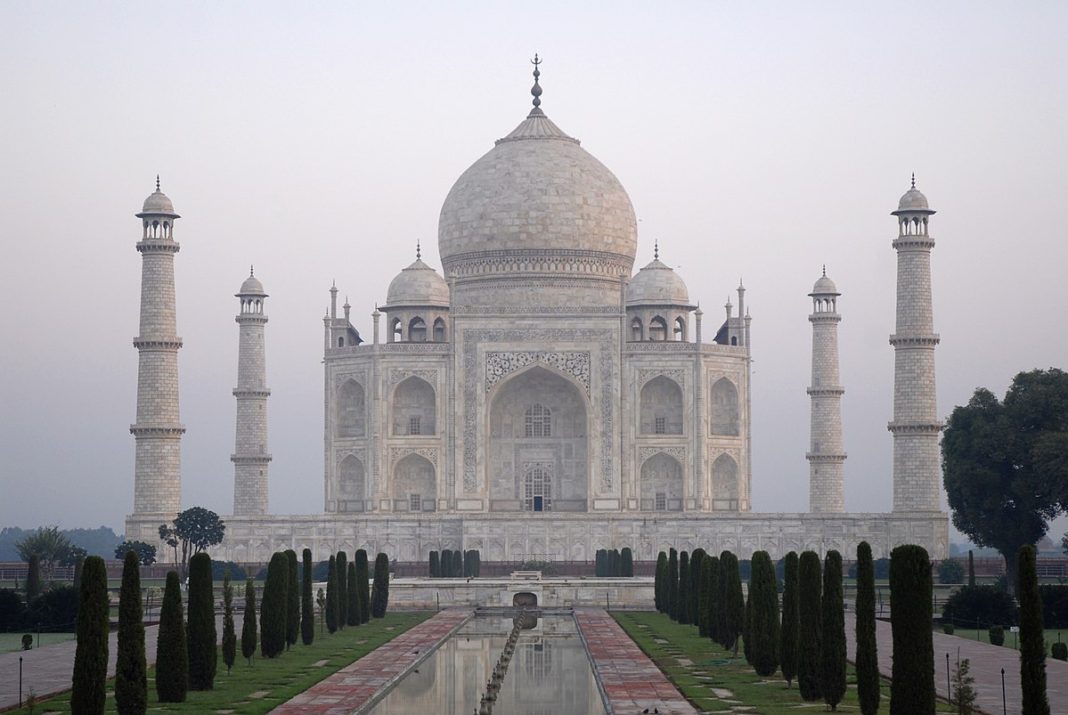““Taj Mahal is not just a monument, but a symbol of love.”
-Suman Pokhrel
Man is a member of the animal world, however they are totally different from the other species because it has the capacity to observe, analyse, and experiment far better than the other species. We, human beings have explored, exploited and modified the gifts of nature as per our own needs and changed many things from its original form over a long period of time. We have built millions of sky scrapes, overhead bridges, and many statutes and monuments all across the Earth wherever we went. Early humans couldn’t explain things and their emotions in words and languages to others, so they started to draw and paint on the walls of the caves, build various historical monuments and architectural masterpieces across the world as a witness for their descendants to remember it for all the time to come. In simple words, we can define architecture as the art and science of designing buildings and structures. A wider definition of architecture would include within this scope the design of any built environment, any structure or object, from town planning, urban design, and landscape architecture to furniture and objects. Architecture could also be defined as the manipulation of shapes, forms, space and light to change the environment around us. Before we go deeper into our topic, let us know more about the history of architecture which will help us understand about the various architectural masterpieces that humans have built across the world.
Introduction to History of Architecture:
Architectural history can be defined as the discipline that records, studies and interprets architecture. It studies its different forms, purposes, and most importantly the revolution of architecture. Fortunately, ancient architecture can easily be observed and recorded. Studying the architectural history enables us to understand the society and culture that these architectural masterpieces represent which is very useful when working as a contemporary architect. Comparing and studying ancient and contemporary architecture is very essential in architecture. It helps an architect to consider buildings or cities as more than a visual phenomenon and therefore the architect would have a more fundamental and culturally inclusive approach to the field of architecture than an approach based purely on architect’s own taste or style. So, studying the history of architecture is extremely important because unlike studying history in other disciplinary groups, the purpose of studying the history of architecture when practicing contemporary architecture is to understand how architecture influences the society, the people and its culture.
In other words, students can study the history of architecture in order to understand how and why each era since the beginning formed its own unique style and architecture. The “why’’ is what really must be understood by architects in order to produce the kind of a architecture our contemporary society needs because architecture should reflect the philosophies prevalent at any given time or place.
However, the architectural history, similar to any other form of historical study, is subject to the limitations and subjectivity of history as a discipline. It is important to understand why a certain building was created a certain way in any given point in history; for example, the feudal castles were built with not only defence in mind, but also to allow civilians and livestock to come inside and stay safe during a time of war; whereas the gothic architecture was designed in order to inspire awe in the minds of the congregation every time anyone saw them. This awe lingers within us even today.
The study of architectural history can also be a good way to inspire our modern day architects into trying new forms of design. Without access to differing styles and patterns of architecture, a designer would become stagnant and locked into one kind of building. If nothing else, the study of historical architecture will really help us to stimulate the creative juices in the minds of the students and this will make for more creative and flexible architects overall. For these reasons, it is very important to study ancient architecture and learn the how and why these buildings were constructed by the people in the past. Now, let us take a look at one of the most popular and famous architectural masterpieces that humans have ever constructed in the history: The Taj Mahal.
Short Introduction to the World-Famous Taj Mahal:
Taj Mahal is a historical monument that needs no introduction. This monument is very peculiar because in the list of the Seven Wonders of the World. No wonder people swarm in flies and come in thousands to India all year round to witness the magnificence of its beauty. This monument is located in India in the heart of Agra in Uttar Pradesh. In other words, Taj Mahal is the only architectural masterpiece in India that clearly reflects the Mughal architecture with its splendour and glory.
Taj Mahal is one of the main reasons why India is famous and is visited by people across the globe. Many people and tourists even associate India with Taj Mahal. However, to me, more than the splendid architecture and the glory, it is the story behind it that appeals to me the most. This magnificent beauty stands strong as the symbol of the love of a husband to his dear wife. Moreover, it reminds us of the wonderful power of love and how it can set an example for all the generations to come.
History of Taj Mahal:
The famous Taj Mahal was constructed under the reign and guidance of the famous Mughal Emperor Shah Jahan. This monument was built as on ode to his beautiful wife Mumtaz Mahal and the real love between two of them. The construction of Taj Mahal started in the year 1632 and it is strongly said that it took approximately 20,000 workers to work relentlessly for almost 20 years to finish the entire construction of this beautiful monument.
After the death of his beloved wife Mumtaz Mahal, the emperor Shah Jahan decided to build a monument that will bear a strong witness to his dedication to their love. So he called on the finest artists from all across the country to build the Taj Mahal. He wanted Taj Mahal to be unlike any monument ever built on earth; he wanted it to be truly unique. The emperor planned this to be the last gift to his beloved wife. Under the tomb of Taj Mahal, the empress remains buried beside her husband Shah Jahan who was also buried next to her after his death.
Why is Taj Mahal so famous?
Taj Mahal is one of the most famous monuments whose ethereal beauty and architectural finesse remains unparalleled for ages since ancient times. For some people it is the beauty of the tomb that attracts them to this glorious monument, but for some others it is the beautiful story behind the construction of Taj Mahal that appeals the most to them. This monument stands proudly in the heart of the city of Agra as a symbol of love between the emperor and his wife. It is seen as the epitome of love and respect that attracts and inspires the people from all over the world to come and witness it’s grandeur for generation after generation.
Taj Mahal– A Unique Symbol of Love
The renowned Taj Mahal was brought to life and its fulfilment by the vision of the Mughal Emperor Shah Jahan. He got this beautiful monument built for his beloved wife, Mumtaz Mahal after she passed away.
To honour the memory of his loving wife, Shah Jahan ordered the finest artisans from all over the world and India to build the monument as the last gift to his dear wife. He was determined to make something that had never been done before for anyone. The emperor wished to give Taj Mahal as the last gift to his wife whom he loved very much.
Even today, people sing praises about Shah Jahan’s grand gesture to his wife Mumtaz Mahal. It makes you believe in the power of true love and appreciate it like never before. We also see how under the tomb in Taj Mahal lies the body of the eternal lovers. Shah Jahan and Mumtaz Mahal are buried next to each other and even after death, they remained side by side and by this they are showing us that no one can separate the true lovers even after death.
The Architecture of Taj Mahal:
Now, let’s take look at the architecture of the famous monument along with some interesting stories and facts behind it. In 1983, UNSECO declared the most Taj Mahal as a world Heritage Site. The structure of the tomb and the monument is made from the finest white marble. It is said that the best white marble was imported from countries across the world for its construction. Before finalizing the architecture of Taj Mahal, the Mughal emperor Shah Jahan extensively went through a number of architectural designs for Taj Mahal and also rejected some of them. The walls of the Taj Mahal are meticulously engraved with precious gem stones from all across the world. The design of the monument Taj Mahal involves traits of smart Mughal architecture. Each of the four pillars around the main tomb has a special name for itself. This was planned to prevent the monument from being damaged by natural disasters like earthquakes. The unique feature of Taj Mahal is that its architectural style combines perfectly with the features of Persian, Turkish, Indian and many more architectural styles and designs.
Apart from the main building, there are many other things to admire in and around the Taj Mahal. Leading the way to the beautiful marble tomb is a beautiful fountain along with a number of water channels. The beautiful reflection of the monument on the waters adds a different level to the serenity of the monument. The Taj Mahal looks magical with different colours on a full-moon night.
One Interesting story behind Taj Mahal:
While we have seen many great aspects about the history and the architecture of Taj Mahal, let us now see an interesting story behind the world-famous monument which people talk about even now. Taj Mahal, the magnificent monument that stands at the heart of India has a story behind it that has been melting the hearts of millions of listeners since the time Taj has been visible. A story, that although ended back in 1631, continues to live on in the form of Taj and is considered a living example of eternal love between the emperor and his wife. It’s the love story of Shah Jahan and Mumtaz Mahal, two people from the course of history who set a beautiful example for the people living in present and the future generations to come. The famous English poet, Sir Edwin Arnold best describes it as “Not a piece of architecture, as other buildings are, but the proud passion of an emperor’s love wrought in living stones is the Taj Mahal.” The story that follows this quote next will prove why the statement is true.
Shah Jahan who was also called Prince Khurram, was born in the year 1592. He was the son of the emperor Jehangir who was the fourth Mughal ruler of India and the grandson of Akbar the Great. In 1607 when he was strolling down the Meena Bazaar, accompanied by a string of fawning courtiers, Shah Jahan caught a glimpse of a beautiful girl hawking silk and glass beads. He loved her because it was love at first sight and the girl was Mumtaz Mahal, who was known as Arjumand Banu Begum at that time. In those days, he was just 14 years old and she, a Muslim Persian princess, was 15. After meeting her, Shah Jahan immediately went back to his father and declared that he wanted to marry her as soon as possible. The match got solemnized after five years i.e., in the year 1612.
It was in the year 1628 that Shah Jahan became the Mughal Emperor of India and entrusted Arjumand Banu with the royal seal. He also bestowed and honoured her with the title of Mumtaz Mahal, meaning the “Jewel of the Palace”. Though Shah Jahan had other wives also, but, Mumtaz Mahal was his most favourite and she accompanied him everywhere, even on military campaigns. Unfortunately in the year 1631, when Mumtaz Mahal was giving birth to their 14th child, she died due to some complications. While Mumtaz was still lying on her deathbed, Shah Jahan promised her that he would never remarry any other woman and he assured her that he will build the richest mausoleum over her grave.
It is said that Shah Jahan was so heartbroken after the death of Mumtaz Mahal that he ordered the court into mourning for two whole years. Sometime after her death, Shah Jahan undertook the task of erecting the world’s most beautiful monument in the memory of his beloved wife Mumtaz Mahal. It is said that it took 22 long years and the labour of about 22,000 workers to construct the monument. When Shah Jahan died in the year 1666, his body was placed in a tomb next to the tomb of Mumtaz Mahal. This magnificent monument came to be known as the great “Taj Mahal” and now counts amongst the Seven Wonders of the World. This is the true story behind the making of the famous Taj Mahal of India, which has mesmerized many people with its bewitching beauty.
One Interesting fact about Taj Mahal:
The Taj Mahal can change colours:
The great Taj Mahal is indeed a big wonder in many senses. The colour of the Taj Mahal varies as per the time of the day and the condition of the sky. It gives out a slightly pinkish colour during the early morning hours. During the evening, the beautiful Taj looks milky white. At night time, under the moonlight, the Taj Mahal gives out a light blue colour and this is indeed a fascinating view which everyone must see at least once during their lifetime.
Truth or Myth
This is a very true fact about the monument and you can view the changing colour mood of the Taj Mahal yourself on your next visit.
Making of Taj Mahal
The famous Taj Mahal was declared as a World Heritage Site by UNSECO in 1983. What is the thing that makes this monument so special? Why do people come from all walks of life to witness its beautiful and glorious magnificence? Taj Mahal is entirely made out from white marble. Subsequently, this costly white marble was exported from various countries from all over the world during the reign of Shah Jahan.
They began constructing the monument in 1630 and it finally got completed in a time span of almost 20 years. It is said that Shah Jahan rejected numerous designs before finally settling on the present structure of the beautiful Taj Mahal. The walls of the monument are engraved with quite expensive stones which are exported from countries across the globe.
Taj Mahal is a wonderful monument which involves a lot of smart architecture. The four pillars that stand in the four corners are inclined a little at an angle. This was done to prevent the falling of the minarets on the monument from any kind of natural disaster. Literally, we can say that Shah Jahan spent a hefty amount of money in the making of Taj Mahal.
In addition, we saw how the building of this structure required about 20,000 workers approximately to get the work completed in 20 years. Moreover, the architecture of Taj Mahal was inspired and influenced by several architecture styles like Indian, Turkish, Persian and even more.
How to reach Taj Mahal?
Taj Mahal is situated in the heart of the city of Agra, which is in turn located at 204 kilometres to the south of New Delhi.
By Road –There are bus services that can help you to reach to Agra from a bunch of important cities, such as Delhi, Jaipur, Mathura and Fatehpur-Sikri, among others. Anyways, local transportation then can also get you to the place.
By Rail –The rest of the nation can easily reach Agra with the help of the cheapest mode of transport-The railways. There are about three stations to go to Agra, the main Agra Cantonment as well as two others of Raja-Ki-Mandi and Agra Fort, which are near Taj Mahal. Trains such as Rajdhani, Taj Express, Shatabdi and Palace on Wheels are the main ones which can you to Agra from Delhi.
By Air –The city of Taj Mahal, Agra has its own airport, which can be accessed by any airlines from all over the nation.
In and Around Area and location of Taj Mahal:
The great and famous Taj Mahal is located on the right bank of the great Yamuna River in a vast Mughal garden that encompasses nearly 17 hectares, in the heart of Agra District in Uttar Pradesh. It was built by the then Mughal Emperor Shah Jahan in memory of his dear wife Mumtaz Mahal with construction starting in 1632 AD and completed in 1648 AD, with the grand mosque, the beautiful guest house and the main gateway on the south, the outer courtyard and its cloisters were added subsequently and completed in around 1653 AD. The existence of several historical and Quaranic inscriptions of God Allah in Arabic script have facilitated setting the chronology of Taj Mahal. It is widely said that for its construction, masons, stone-cutters, inlayers, carvers, painters, calligraphers, dome builders and other artisans were requisitioned from the whole of the empire and also from the Central Asia and Iran. It is an unknown fact that many people don’t even know that the Taj Mahal was not built by an Indian, instead Ustad-Ahmad Lahori a Persian Muslim was the main architect of the Taj Mahal.
The Taj Mahal is considered to be the greatest architectural achievement in the whole range of Indo-Islamic architecture till date. Its recognised architectonic beauty has a rhythmic combination of solids and voids, concave and convex and light shadow; such as arches and domes further increases the aesthetic aspect of value and so more people like to see it. The beautiful and amazing colour combination of lush green scape reddish pathway and blue sky over it show cases the monument in ever changing tints and moods. The relief work which is fully done in marble and inlay with precious and semi precious stones make it a monument apart.
It is being widely said that the uniqueness of Taj Mahal lies in some truly remarkable innovations carried out by the horticulture planners and architects of the architect King- Shah Jahan. One such genius planning of the emperor is the placing of tomb at one end of the quadripartite garden rather than in the exact centre, which added rich depth and perspective to the distant view of the beautiful monument and it is also, one of the best examples of raised tomb variety today. The tomb of the emperor and his wife is further raised on a square platform with the four sides of the octagonal base of the minarets extended beyond the square at the corners. The top floor of the platform is reached through a lateral flight of steps provided in the centre of the southern side of the Taj. The ground plan of the monument Taj Mahal is in perfect balance of its composition, the octagonal tomb chamber in the centre, encompassed by the portal halls and the four corner rooms. The plan is repeated on the upper floor of the monument. The exterior of the tomb is square in plan, with well chamfered corners. The large double storied domed chamber, which contains the cenotaphs of the famous Mumtaz Mahal and Shah Jahan, is a perfect octagon in plan. The exquisite octagonal marble lattice screen encircling both cenotaphs is a piece of superb workmanship done with great effort and enthusiasm. It is highly polished and richly decorated with beautiful inlay work. The borders of the frames of the tomb are inlaid with precious stones representing flowers executed with wonderful perfection. The colours and the shades of the stones used to make the leaves and the flowers appear almost real. The cenotaph of Mumtaz Mahal, wife of Shah Jahan is in perfect centre of the tomb chamber, placed on a rectangular platform decorated with inlaid flower plant motifs. The cenotaph of the great legend Shah Jahan is greater than Mumtaz Mahal and installed more than thirty years later by the side of the latter on its west. The upper cenotaphs are really nothing but only illusory and the real graves are in the lower tomb chamber (crypt), a practice adopted in the imperial Mughal tombs.
The four free-standing minarets at the four corners of the raised platform added a hitherto unknown dimension to the Mughal architecture. The four minarets provide not only a kind of spatial reference to the monument but they also give a three dimensional effect to the edifice.
The most impressive part in the Taj Mahal complex next to the tomb, is the main gate which stands majestically in the centre of the southern wall of the forecourt. The gate is flanked on the north front by double arcade galleries for visitors. The garden that is present in front of the galleries is subdivided into four quarters by two main walk-ways and each quarters in turn subdivided by the narrower cross-axial walkways, on the Timurid-Persian scheme of the walled in garden. The enclosure walls on the east and west have a pavilion at the centre between them
The Taj Mahal is a perfect beautiful symmetrical planned building, with an emphasis of bilateral symmetry along a central axis on which the main features of Taj Mahal are placed. The building material used for making the Taj is brick-in-lime mortar veneered with red sandstone and marble and inlay work of precious/semi precious stones. The grand mosque and the beautiful guest house in the Taj Mahal complex are built our of red sandstone in contrast to the marble tomb in the centre. Both the buildings have a large platform over the terrace at their front for the people to walk. Both the grand mosque and the guest house are the identical structures. They have an oblong massive prayer hall consisting of three vaulted bays arranged in a row with central dominant portal. The frames of the curved portal arches and the spandrels are veneered in white marble. The spandrels are filled with flowery arabesques of stone intarsia and the arches bordered with rope moulding.
Taj Mahal represents the finest Mughal architectural and artistic achievement through perfect harmony and excellent craftsmanship in a whole range of Indo-Islamic sepulchral architecture till date. It is a masterpiece of architectural style in conception, treatment and execution and has unique aesthetic qualities in balance, symmetry and harmonious blending of various elements, styles and designs.
Integrity:
Integrity is maintained in the intactness of tomb, mosque, guest house, main gate and even in the whole Taj Mahal complex. The physical fabric is still in a very good condition and structural stability, nature of foundation, verticality of the minarets and other constructional aspects of Taj Mahal have been studied and continue to be monitored even today. To control the impact of deterioration on the monument due for atmospheric pollutants, an air control monitoring station is installed near the Taj Mahal to constantly monitor air quality and control decay factors as they arise. To ensure the protection and maintenance of the setting, the adequate management and enforcement of regulations in the extended buffer zone is urgently needed. In addition to this, future development for tourist facilities will need to ensure that the functional and visual integrity of the property is maintained, particularly in the relationship with the Agra Fort.
Authenticity:
The glorious tomb, grand mosque, beautiful guest house, main gate and the overall Taj Mahal complex have maintained the conditions of authenticity at the time of inscription. Although an important amount of repairs and conservation works of the Taj Mahal have been carried out right from the British period in India, these have not compromised to the original qualities and beauty of the buildings. Future conservation work will need to follow all the precautions and guidelines that ensure that qualities such as form and design continued to be preserved for the time to come.
Protection and management requirements of Taj Mahal:
The entire protection and management of Taj Mahal complex is carried out by the Archaeological Survey of India and the legal protection of the monument and the control over the regulated area around the monument is through the various legislative and regulatory frameworks that have been established in India, including the Ancient Monument and Archaeological Sites and Remains Act 1958 and Rules 1959 Ancient Monuments and Archaeological Sites and Remains (Amendment and Validation); which is adequate to the overall administration of the property and of buffer areas as well as zones. Additional supplementary laws along with these departments ensure the protection of the property in terms of development in the surroundings.
An area of 10,400 sq km around the Taj Mahal is defined and specially developed to protect the monument from pollution like air and water pollution. The Supreme High Court of India in December 1996, delivered a permanent rule banning use of coal/coke in industries located in the Taj Trapezium Zone (TTZ) and switching over to the natural gas or relocating them outside the TTZ zones to ensure that the monument remains pollution-free for the generations to come. The TTZ zone comprises of 40 protected monuments including three most important World Heritage Sites which are the Taj Mahal, Agra Fort and the Fatehpur Sikri.
The fund provided by the federal government for the protection is adequate for the buffer areas. It is more than enough for the overall conservation, preservation and maintenance of the complex to supervise activities at the site under the guidance of the Superintending Archaeologist of the Agra Circle which is located in Agra to help conserve the beauty of Taj Mahal. It becomes highly necessary that the implementation of an Integrated Management plan to ensure that the property maintains the existing conditions, particularly in the light of significant pressures derived from visitation that will need to be adequately and properly managed and protected. The Management plan should also prescribe proper guidelines for proposed infrastructure development in that area and establish a comprehensive Public Use plan. It is also highly important that we, as Indian citizens should work towards protecting the world-famous monument which is now seriously threatened by high air pollution.
Conclusion:
In conclusion, Taj Mahal is indeed a symbol of love and a monument that each and every Indian must be proud of. It is a very true fact that the Taj Mahal is the proudest instance of fine Mughal architecture in India and even in the whole world. Its historical as well as architectural and cultural significance is so high that it is enlisted as a World Heritage Site by UNESCO. With an unparalleled beauty and love in every brick of it, the Taj is a monument to admire and analyse carefully. It is true that each architectural masterpiece has its own importance. The significance of the great Taj Mahal is in its architectural craft and beauty, which has made it a very unique masterpiece from across the whole world. In addition to this fact, the love of Shah Jahan to his wife Mumtaz Mahal has made a successful attempt to infuse life of love in this beautiful building. By seeing the Taj Mahal, even the lovers themselves sing songs of love with each other. That’s why Taj Mahal is one of the most favourite architectural masterpiece that everyone wants to visit in this world. And the beautiful love story of Shah Jahan and Mumtaz Mahal behind its construction makes it an epitome of love between them as well.
By Mathew George










